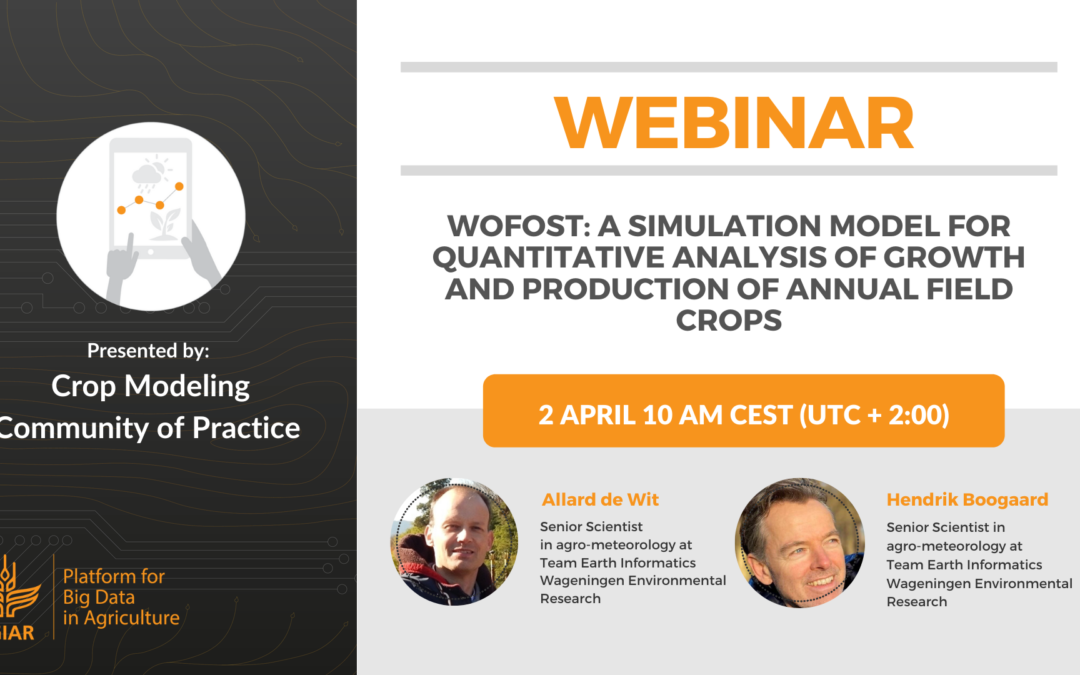Webinar – WOFOST (WOrld FOod STudies): A simulation model for quantitative analysis of growth and production of annual field crops
Webinar organized by the Crop Modeling Community of Practice of the CGIAR Platform for Big Data in Agriculture.
Click here to download the PDF of the webinar presentation.
WOFOST is a simulation model for the quantitative analysis of the growth and production of annual field crops. It is a mechanistic, dynamic model that explains daily crop growth on the basis of the underlying processes, such as phenological development, CO2-assimilation, transpiration, respiration, partitioning of assimilates to the various organs, and dry matter formation and how these processes are influenced by environmental conditions. With WOFOST, you can calculate potential and attainable crop production, leaf area, water use, etc. for a location given knowledge about soil, crop, weather and crop management (e.g. sowing date).
As an open source model, WOFOST has been used by many researchers over the world and has been applied for many crops over a large range of climatic and management conditions. It is one of the key components of the European MARS crop yield forecasting system. In the Global Yield Gap Atlas (GYGA) WOFOST is used to estimate the untapped crop production potential on existing farmland based on current climate and available soil and water resources.
In this webinar, organized by the Crop Modeling Community of Practice, a panel of WOFOST experts formed by Allard de Wit and Hendrik Boogaard will introduce WOFOST, explain the basic principles and show some applications including a hands-on training by means of Jupyter Notebooks. After their presentation, webinar attendees will have the opportunity to ask any WOFOST-related questions.
Presenters
Allard de Wit
Senior scientist, agro-meteorology and remote sensing
Team Earth Informatics at Wageningen Environmental Research
Hendrik Boogaard
Senior scientist agro-meteorology
Team Earth Informatics at Wageningen Environmental Research
Follow up on unanswered questions:
Q: Why are there a large number of crop models? what is the difference between WOFOST and DSSAT or APSIM?
A: Historically grown. Models arose within science groups around the world. The different models can have different aims e.g. explore yield levels or advise farmers. DSSAT and APSIM or more modelling frameworks with different models implemented. WOFOST is a single model. However we do have model frameworks: PCSE (Python) and WISS (Java) in which we implemented WOFOST.
Q: Can we integrate DSSAT and WOFOST? or any comparative studies have been done before?
A: To us it is uncertain what you mean with “integration”? DSSAT is a suite of models, so if your aim is to implement WOFOST as part of the DSSAT suite that is possible. To us it is not clear what the advantage would be, there are already at least 14 different implementations of WOFOST in different languages I do not see the added value of a WOFOST implementation under DSSAT.
Q: Does WOFOST simulate soil salinity, does it consider ion toxicity effect on crop production? Is it useful for both saline area and drought area?
A: It is not included in the model, it does not simulate toxicity effect. In Wageningen we do have the SWAP model, it simulates sub surface hydrology and includes sailinite. It also has WOFOST implemented but it misses the ion toxicity. Besides this WOFOST version is still under maintenance to get it aligned with the official WOFOST implementations.
Q: How did define root zone moisture content? is that based on different soil depths? how did you define root depth?
A: WOFOST can have different implementations of a soil water module for simulating the root zone moisture content. Most common is a single bucket model with the root-zone bucket increasing with increasing root depth. We have beta release of a multi-layer water balance in PCSE-WOFOST. Root depth in WOFOST is defined as the maximum depth where roots can effectively extract water.
Q: What about the soil data? Is it rely on a single or dominant soil data (e.g. caly loam)? or it gives us a freedom to use a set of soil data?
A: For a single WOFOST run you have to define a few soil physical characteristics like available water capacity and rooting depth. As long as you can define these properties you can use whatever soil data source available. In case of regional applications you have to decide how you manage soil associations/soil polygons with soil physical units. You could simulate them all, and aggregate results afterwards, or decide to only simulate the dominant one.
Q: Could you talk on how to model soil nutrient distribution using historical harvest data and some soil testing result/data?
A: In situations with limited data like this you are probably better off using the QUEFTS model. QUEFTS can take WOFOST output and estimate further reduction in yield based on seasonal N/P/K supply. Dynamic behaviour of soil nutrients is not part of the model. In Wageningen we do have other models like SWAP-ANIMO that are developed for soil nutrient behaviour but in that case it is focused on environmental issues like nutrient leaching to ground and surface water.
Q: What is WOFOST future research direction?
A: See presentation, slide 21.
Q: How can I download the WOFOST software? Is it compulsory its run in DSSAT? What are the required files to run the simulation?
A: See presentation, slide 14. No WOFOST does not run in DSSAT. More information on how to run WOFOST and what input are required can be found via the portal.
Q: How many crops are simulated?
A: WOFOST is multi-crop thus in WOFOST you can parametrize many different annual arable crops as long as you have sufficient field/experiment data to calibrate the parameters for the specific crop. Currently crop parameter files for 22 crops are available.
Q: Are the results from WOFOST useful enough at a scalable level such as country at higher spatial resolution?
A: Yes, see our examples on WOFOST and GYGA in the presentation.
Q: Will the participants access the Jupiter Notebooks for hands-on?
A: Yes a demonstration was given in the webinar. Everyone can run the notebooks by getting them from GitHub.
Q: Could you explain the role of WOFOST in the Global Yield Gap Atlas (GYGA) and how you address issues like soil variability in these large scale modeling exersizes?
A: See presentation, slide 10-11.
Q: Especially interested in possibilities for nutrient flows and balances.
A: See presentation, slide 5 and background documentation of WCC/WOFOST (2.1 / 7.1.7) via the portal.
Q: Can this model be use to simulate green house gases emission from different Management practices (different tillage system, fertilizer rates, and farming systems).
A: No, it is not included in WOFOST as we aim in other type of modeling.
Q: What is the ability of WOFOST to simulate perennial cropping system? Is there any possibility to add new crops (such as prennials/medicinal plants) to WOFOST?
A: You can add different crops but perennial is a difficult one because the management it is very important and necessary to understand the cycles. Nevertheless, we are sure that the many of the approaches in WOFOST could be reused for a perennial (assimilation, respiration, phenology) but an extensive field dataset and a good understanding of the perennial cropping system will be required. In fact, it has been done by others here.
Q: How do you calibrate WOFOST? What reference data? What model output?
A: See WOFOST portal. There is a document on calibration under documentation. PCSE-WOFOST has a Jupyter notebook on calibration
Q: Can the model accommodate limited data run simulations?
A: There is a minimum data set needed on weather, soil and crop. See for more information PCSE-WOFOST and the Jupyter notebooks.
Q: I assume it is a deterministic model. Do the predictions come with confidence bands?
A: No it does not provide confidence bands in itself, but you can always rerun WOFOST with perturbed inputs to generate the uncertainty bands yourself.
Q: Is it possible to combine WOFOST model in GIS?
A: Yes, technically possible, but we mainly use GIS to visualize the results from a regional WOFOST simulation. Our regional application are therefore not implemented in GIS but other environments (e.g. a relational database) depending on the project. We do use GIS in the pre-processing for instance to create the spatial schematization and the unique simulation units via a GIS overlay.
Q: My question concerns more the practical aspect of using WOFOST to predict seasonal yields. How heavy is the parameterisation of the model? What are the minimum requirements for crop and soil parameterization?
A: There is a minimum data set needed on weather, soil and crop. See for more information PCSE-WOFOST and the Jupyter notebooks. Soil parametrization is simple (available water capacity and rooting depth). Crop parametrization is more complex. See WOFOST portal. There is a document on calibration under documentation. PCSE-WOFOST has a Jupyter notebook on calibration.
Q: What about the integration of remote sensing in WOFOST model?
A: We have done several studies on assimilating remote sensing data in the model. See WOFOST portal section on documentation.
Q: What is the basis for phenology calculation? Is it implement GDD or other thermal indices?
A: It is GDD possibly combined with the effect of photoperiod and vernalization.
Q: Is there a generic software to calibrate the model?
A: For PCSE-WOFOST we do have Jupyter notebooks to support the user in the calibration process. We also have a software called CalibrationManager which can do complex regional calibrations. However, setting up all inputs for CalibrationManager is a tedious and often it is quicker to develop your own approach, for example based on the Jupyter notebooks available. Nevertheless, the CalibrationManager can be made available on request.
Q: What is the process for creating new YAML files for new crops?
A: Copy an existing file of a most similar crop and calibrate the crop parameters following the calibration protocol. Of course the requires some observed field data. See WOFOST portal. There is a document on calibration under documentation. PCSE-WOFOST has a Jupyter notebook on calibration.
Q: Is there a way to test the SWAP model?
A: Click here for more information on SWAP.
Q: What will be the minimum experiment data required for calibrating WOFOST model for particular crop?
A: Planting date and crop cycle length assuming that you take all other crop parameters from another existing crop parameter file of the most similar crop. Preferably also information on the potential biomass of the different plant organs plus leaf area index for different yield levels.
April 2, 2020







